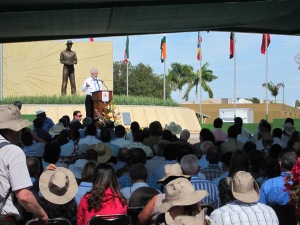By Meghan Eldridge
CIUDAD OBREGON, Mexico — The results of agricultural work that began in the wheat fields of Mexico in 1944 are now present on 70 million hectares of land worldwide and celebrated today.

Thomas Lumpkin, director general of CIMMYT, presents at Tuesday’s opening ceremony. The ceremony featured speakers who explained Borlaug’s contributions to agricultural advances. Photo by Meghan Eldridge
Norman Borlaug, known by many as the father of the Green Revolution, started his fieldwork in the 1940s researching wheat strains in the Yaqui Valley near Ciudad Obregon, Mexico. His work began a period of increased global crop productivity called the Green Revolution.
Borlaug is credited with saving a billion people from starvation in Latin America and Asia between the 1940s and ‘60s. Tuesday marks the beginning of a weeklong conference held in Ciudad Obregon called the Borlaug 100, a celebration of Borlaug and the wheat strains that began the Green Revolution.
The conference, hosted by CIMMYT, the International Maize and Wheat Improvement Center, began at 8 a.m. March 25 with a field day. Conference attendees were bused from hotels to tour wheat plots where Borlaug conducted the testing that made him famous.

Conference attendees listen to a speaker at a stop on the field tour Tuesday morning. The field tour lasted about five hours and included information about types of research going on in the Yaqui Valley. Photo by Meghan Eldridge
The site where Borlaug once performed genetic testing and plant breeding is now home to more than 250,000 observation plots, 100,000 of which are wheat plots run by CIMMYT researchers who continue Borlaug’s work.
Borlaug focused his efforts on developing higher yield wheat strains resistant to crop diseases and drought conditions in the face of a growing world population. His research continues to inspire farmers, scientists and policymakers as the world prepares to confront a population of 9.2 billion people by 2050 and increasingly prominent environmental changes.
At Tuesday’s opening ceremony, the day that would have been Borlaug’s 100th birthday, speakers recalled Borlaug’s influence. Borlaug died in 2009.
Thomas Lumpkin, director general for CIMMYT, presented at the ceremony.
“Norman Borlaug was a child of humble beginnings,” Lumpkin said. “He was an unlikely candidate to receive the distinction of being one of the most influential people of the 20th century.”
Borlaug was determined to succeed with research efforts in Mexico despite rough field conditions and complications from stem rust on wheat plants, Lumpkin said.
“Borlaug was as durable as the wheat he would one day develop,” he said.
People from all areas of the agricultural enterprise worldwide, from farmers and crop researchers to university students and economists, are attending the Borlaug 100. Throughout the week, attendees will hear from leading researchers working across the globe to achieve the same goal Borlaug had at the start of his own revolution: increase food production and create a world where hunger doesn’t exist.

Pingback: Kenyan Economist Speaks on Behalf of Farmers | MU Earth